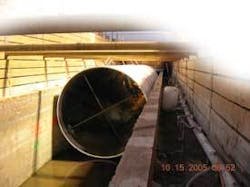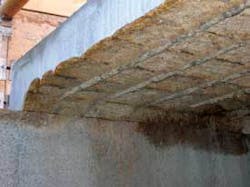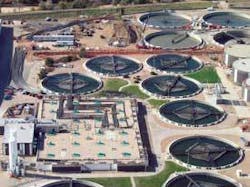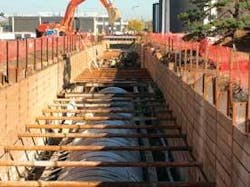by Bill Wemmert
The first sign of trouble in the regional wastewater treatment plant that serves the 2.5 million residents of the greater Denver area occurred in 1999 when a primary wastewater conduit at the plant collapsed. Wastewater treatment in the area has, for the past 40 years, been provided by Metro Wastewater Reclamation District, the largest wastewater treatment facility in the Rocky Mountain West. With more than 60 connectors, Metro’s plant can treat up to 227 million gallons per day (mgd).
Following the collapse of the North Primary Effluent Transfer Conduit, Metro initiated a program to review and assess the South Primary Effluent Conduit (SPEC) as well as other plant conduits and pipelines. The inspection of the SPEC, conducted by URS in 2000, revealed significant deterioration of the conduit roof and upper sidewalls. Immediate monitoring of the structure and the development of a rehabilitation plan were required to prevent a collapse of the conduit which would have resulted in significant safety hazards as well as serious operational, environmental, and regulatory problems at Metro’s central plant.
Constructed in 1976, the SPEC is a 1,300-linear-foot, 12-foot-wide by nine-foot-high, reinforced concrete box culvert that conveys up to 125 mgd from the North and South Plant Primary Clarifiers to a pump station that feeds the South Plant aeration basins. The SPEC is buried beneath 10 feet of cover and runs under a concrete-paved access drive through the South Plant. Below the access drive is an extensive utility corridor.
Further Deterioration Discovered
In November 2004, Metro and URS conducted a second survey of the SPEC to aid in the preparation of the final conduit rehabilitation plans. The new inspection revealed additional concrete deterioration where as much as seven inches of concrete had corroded and worn away from the original 14-inch-thick structural concrete roof. It also indicated that the lower reinforcing mat had completely separated from the roof structure at one location.
A plan had to be developed that would meet three criteria: 1) achieve project rehabilitation design objectives while providing for continuous plant operations; 2) prevent any impact on Metro’s long history of meeting effluent discharge requirements; and 3) maintain safety for the public, staff and workers throughout construction.
Rehabilitation Strategy
Several rehabilitation alternatives were considered during preliminary design. They included the installation of a new parallel conduit, removing the SPEC roof and replacing it with a PVC-lined precast concrete roof, replacement of the SPEC with large diameter fiberglass reinforced plastic pipe (FRP), and removing deteriorated concrete and replacing it with spray applied concrete (shotcrete).
The selected remedy combined several options. Large diameter FRP was selected to replace the 650 feet of the SPEC that is designed to remain in service for 50 years. The remaining 500 feet of the SPEC, which required only a 10-year design life, was to be rehabilitated with shotcrete and replacement steel which also allowed for this section to be completed in place without requiring excavation of the conduit. The FRP alternative inherently provides a complete barrier against future hydrogen sulfide attack, and the speed at which the large diameter pipe can be installed reduced the installation time and the cost of installation.
Overcoming Obstacles
The project site presented a number of obstacles that had to be resolved. With limited space on site, making room for all construction materials and equipment was difficult. Space was required for excavated soil, construction offices, bypass-pumps, and associated pipelines. The existing utility pipelines and other materials and supplies also had to be temporarily relocated.
The utility corridor contained numerous plant process utilities, including potable water, plant-chlorinated water, waste-activated sludge, raw sludge and scum, as well as power. The SPEC corridor ran under a major plant access road and was located between primary clarifiers, secondary clarifiers and digesters. To implement the rehabilitation project, it was necessary to excavate the utilities and relocate them in temporary pipelines.
The deteriorated state of the existing conduit roof made it necessary to impose a load limit on all equipment used over the SPEC. The contractor had to use smaller, lighter excavating equipment because heavy equipment could have collapsed the conduit. The difficulty was resolved by using two mini-excavators operating on top of the SPEC and long-reach equipment staged outside the trench alongside the SPEC to remove the materials from the excavation.
While rehabilitating the SPEC, a bypass pumping system provided capacity to pump up to 125 mgd of wastewater around the construction. Thirteen 10-mgd diesel-powered bypass-pumping units and 20,000 feet of 18-inch pipelines were used to bypass such large flows and provide redundancy. This volume was based on the anticipated normal wastewater load plus a peaking factor in the event a significant rainfall should occur during construction.
Operations, Economics
Method of Procedure Plans (MOPs) were prepared for all construction activities that might impact wastewater treatment operations. Drafted prior to construction and finalized by the contractor during construction, the MOPs significantly enhanced coordination between the contractor and Metro and helped assure that operations continued while the rehabilitation project proceeded.
The plans addressed every plant operation that could possibly be affected by the project, how those operations might be affected, and who should be contacted if any problems arose. A MOP was created for every shutdown or any other activity that might affect operations. In addition, the work outlined in the MOPs was evaluated both for possible conflicts and for complimentary opportunities with work in other concurrent projects ongoing at the Metro plant.
The project design and bid process included alternative rehabilitation methods and materials in order to obtain the most cost-effective solutions through the bidding process, which was also used to establish the best price for bypass-pumping. The cost of bypass-pumping during construction was significant and presented a potential liability to the project while in operation. It was essential therefore to keep the time of bypass pumping to a minimum, and each proposed solution was weighed against how quickly it could be implemented.
Wastewater treatment continued uninterrupted while the rehabilitation proceeded and the project was completed on time and under budget.
About the Author:
Bill Wemmert, P.E., is a Senior Engineer with URS Corp. in Denver, CO. He has over 25 years of experience in civil engineering, water resources, and environmental industries. He has specialized in the planning, design and construction of water and sewer pipelines, water treatment and wastewater treatment plants and storm drainage facilities.







